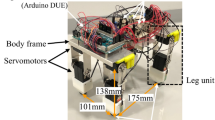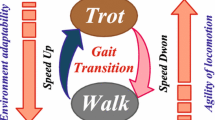Abstract
The biomimetism is based on the observation and imitation of nature. It is expected, by studying live walking animals, to find interesting parameters that could be used in various fields of robotics [1], and to find parameters that don’t vary from one specie to another [2]. The steps described here are the different experiments and the conception of a computer model. Different animals have been studied in the past like the hedgehog, the tenrec and the shrew, and a first model has been achieved. A new model, which is based on the tortoise of Hermann, consists in a 15 links, 22 degrees of freedom system, animated with Proportional-Derivative control, which references are actual recordings of live animals.
Access this chapter
Tax calculation will be finalised at checkout
Purchases are for personal use only
Preview
Unable to display preview. Download preview PDF.
Similar content being viewed by others
References
A. C. Smith, M. D. Berkemeier (1990) Passive dynamic quadrupedal walking. In IEEE, Proceedings of International Conference on Robotics and Automation.
Alexander, R. M. (1984) The gaits of bipedal and quadrupedal animals. International Journal of Robotics Research, vol. 3, pp. 49–59.
Villanova, J. (2003) Simulation dynamique de quadrupèdes inspirés d’animaux reels. Ph.D. thesis, Université Paris VI.
W. F. Walker, Jr. (1971) Structural and functional analysis of walking of the turtle, chrysemys picta mariginata. Journal of Morphology, vol. 134, pp. 195–214.
J. Schmiedeler, R. Siston, K. J. Waldron (2002) The significance of leg mass in modelling quadrupedal running gaits. In CISM/IFToMM, Udine, Italy.
A. Prochazka, S. Yakovenko (2001) Locomotor Control: From Spring-Like Reactions Of Muscles To Neural Prediction.
Marhefka, D. W. (2000) Fuzzy Control and Dynamic Simulation of a Quadruped Galloping Machine. Ph.D. thesis, Ohio State University, Columbus, USA.
J. S. R. Jang, E. Mizutani (1996) Levenberg marquardt learning for anfis learning. In Biennal Conf. of the N. American Fuzzy Information Processing Society, Berkeley, CA, pp. 87–91.
L. Palmer, D. Orin, D. Marhefka J. Schmiedeler K. Waldron (2003) Intelligent control of an experimental articulated leg for a galloping machine. In IEEE Proceedings of the International Conference on Robotics and Automation, Taipei, Taiwan.
Author information
Authors and Affiliations
Editor information
Editors and Affiliations
Rights and permissions
Copyright information
© 2006 Springer-Verlag Berlin Heidelberg
About this paper
Cite this paper
Hennion, B., Pill, J., Guinot, J.C. (2006). A Biologically Inspired Model For Quadruped Locomotion. In: Tokhi, M.O., Virk, G.S., Hossain, M.A. (eds) Climbing and Walking Robots. Springer, Berlin, Heidelberg. https://doi.org/10.1007/3-540-26415-9_5
Download citation
DOI: https://doi.org/10.1007/3-540-26415-9_5
Publisher Name: Springer, Berlin, Heidelberg
Print ISBN: 978-3-540-26413-2
Online ISBN: 978-3-540-26415-6
eBook Packages: EngineeringEngineering (R0)




